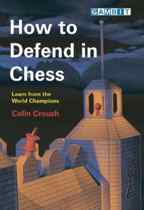How to Defend in Chess
Colin Crouch

While it is well known that amateurs are into attacking their opponents King, the word is out that modern grandmaster chess is also (just like amateur chess!) about dynamic play (and, of course, intense opening preparation). For this reason, an endless stream of books about openings, tactics, and attacking techniques is glutting the market and rapidly absorbing what remains of the rainforests.
Apparently, amateurs think of themselves as intellectual boxers, walking towards each other with swinging fists (sans footwork) and (if they are lucky) iron jaws; blocking punches never seems to occur to them. Though this might work at the lowest levels of the game and Ive even seen an occasional berserker 2400 player get away with this mentality a titled player quickly learns to bob, weave, and clinch when things get a bit out of control. In other words, the good players know how to attack, but they also can play quietly and defend.
Like it or not, defense is a major part of chess, but its a skill that very few of us have ever really nurtured. Looking at the available literature, this problem is exacerbated by the scarcity of available books on the subject. In the old The Art Of The Middlegame by Keres and Kotov, Keres presents a wonderful section on defending difficult positions. In 1975, Andy Soltis gave us more to chew on with his excellent The Art Of Defense In Chess. Some years later (1988) we got another good book with the exact same title (The Art Of Defence In Chess), this time by Polugayevsky and Damsky. Note that the Soltis book incorporated the American spelling of the word defense, while the Polugayevsky book used the English spelling (defence). In 1998, Dvoretsky gave us Attack And Defence, though the section on defense was only fifty pages. This, too, was a good piece of work, and one might suppose that enough is enough, whats left to say about such a “boring subject?
Now, in 2007 (Okay, this book originally appeared in 2000. However, if its new to you, then you might as well consider this 2007 reprint to be new too.), we get Colin Crouchs How To Defend In Chess, a book that is so well thought out, so well written, so interesting, and so instructive (no, Colin didnt bribe me to say these things!), that it made me pack up the previously mentioned tomes in favor of this one fascinating title.
What makes Colins work stand out? First, I like the fact that he only uses games involving at least one World Champion (there are a couple of exceptions, but for the most part he faithfully sticks to his theme). This creates a pleasant sense of history that he milks for all its worth. The first twelve pages explore the principles of defense. Here he looks at pre-Steinitz defensive ideas and games (Labourdonnais-McDonnell, Morphy-Anderssen) and then delves into Steinitzs theoretical and practical contributions. A chat about Nimzowitsch follows.
With game collections covering all the World Champions and most top grandmasters, it has always surprised me that Emanuel Lasker has been more or less ignored. There hasn’t been a detailed examination of his style, nor modern notes to his games (though I took this upon myself in a small way in my recent Silman’s Complete Endgame Course. The Lasker chapter in my book is titled Emanuel Lasker, The Art of Endgame Defense). Due to this, it will come as no surprise to the reader that I was absolutely thrilled to discover that the first half of Crouchs book (95 full pages featuring 17 deeply annotated games) was devoted to Laskers famed defensive abilities. Here we see seventeen of Laskers games annotated with a depth that Ive never before seen. He offers discussions of psychology, talks about defensive strategies, and even hands us a bonus when quite a bit of historical data is presented.
The second half of the book also brought a smile to my face. Ive never hidden the fact that Petrosian was one of my favorite players, and here Crouch gives us 103 pages featuring the great Tigrans defensive skills (making use of 17 deeply annotated Petrosian games).
Clearly, Crouch is using a very different approach than the two “Art of titles (both of which worked with specific chapter themes). His book is less compartmentalized, but more readable and far more flowing. Instead of leaping from player to player and example to example, he tries to get into the heads of Lasker and Petrosian, and he uses whole games so you can see how the situation developed, and how they saved themselves from danger or, in many cases, from a veritable abyss. An excellent addition to any chess library, Mr. Crouch gives us in one book, instruction, a history lesson, many deeply annotated games, and excellent glimpses into the lives and art of two chess greats.
If you already own the 2000 edition, dont bother with this one. But if you dont own this fantastic book, get your ass in motion and buy it NOW!
